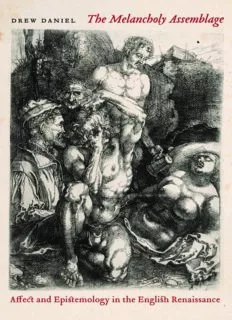
The Melancholy Assemblage. Affect and Epistemology in the English Renaissance PDF
Preview The Melancholy Assemblage. Affect and Epistemology in the English Renaissance
THE MELANCHOLY ASSEMBLAGE THE MELANCHOLY ASSEMBLAGE Aff ect and Epistemology in the Eng lish Ren ais sance Drew Daniel Fordham University Press New York 2013 Copyright © 2013 Fordham University Press All rights reserved. No part of this publication may be reproduced, stored in a retrieval system, or transmitted in any form or by any means— electronic, mechanical, photocopy, recording, or any other—e xcept for brief quotations in printed reviews, without the prior permission of the publisher. Fordham University Press has no responsibility for the pers is tence or accuracy of URLs for external or third-p arty Internet websites referred to in this publication and does not guarantee that any content on such websites is, or will remain, accurate or appropriate. Fordham University Press also publishes its books in a variety of electronic formats. Some content that appears in print may not be available in electronic books. Library of Congress Cataloging-in-Publication Data Daniel, Drew, 1971– The melancholy assemblage : aff ect and epistemology in the English Renaissance / Drew Daniel. pages cm Summary: “This book considers melancholy as an “assemblage,” as a network of dynamic, interpretive relationships between persons, bodies, texts, spaces, structures, and things. In doing so, it parts ways with past interpretations of melancholy. Tilting the English Renaissance against the present moment, Daniel argues that the basic disciplinary tension between medicine and philosophy persists within contemporary debates about emotional embodiment. To make this case, the book binds together the paintings of Nicholas Hilliard and Isaac Oliver, the drama of Shakespeare, the prose of Burton, and the poetry of Milton. Crossing borders and periods, Daniel combines recent theories which have—until now—been regarded as incongruous by their respective advocates. Asking fundamental questions about how the experience of emotion produces community, the book will be of interest to scholars of early modern literature, psychoanalysis, the aff ective turn, and continental philosophy”—Provided by publisher. Includes bibliographical references and index. ISBN 978-0-8232-5127-8 (hardback) — ISBN 978-0-8232-5128-5 (paper) 1. English literature—Early modern, 1500–1700—History and criticism—Theory, etc. 2. Aff ect (Psychology) in literature. 3. Knowledge, Theory of, in literature. 4. Literature and science—Great Britain—History. 5. Art and literature—Great Britain—History. 6. Science in literature. 7. Science— Philosophy. 8. Renaissance—England. I. Title. PR421.A425D36 2013 820.9'353—dc23 2012043868 Printed in the United States of America 15 1 4 1 3 5 4 3 2 1 First edition To my parents and stepparents Contents List of Illustrations ix Ack nowl edgm ents xi Introduction 1 1. From Dürer’s Angel to Harlow’s Monkey 34 2. Three Hundred Years Out of Fashion 67 3. Let Me Have Judgment, and the Jew His Will 92 4. That Within Which Passes Show 120 5. Rhapsodies of Rags 155 6. My Self, My Sepulcher 200 Epilogue: Disassembling Melancholy 229 Notes 253 Bibliography 289 Index 303 vii Illustrations Color plates (following page 48) 1 Isaac Oliver, Edward Herbert, First Baron Herbert of Cherbury, 1610–1 4 2 Nicholas Hilliard, George Cliff ord, Third Earl of Cumberland, 1585–8 9 3 Nicholas Hilliard, The Young Man among Roses, 1587 4 Isaac Oliver, Young Man Reclining Against a Tree, 1590–9 5 Figures 1 Anonymous, Melancholy, Augsburg Calendar, circa fi fteenth century 13 2 Albrecht Dürer, The Despairing, 1515 14 3 Albrecht Dürer, Melencolia I, 1514 40 4 Harry Harlow, Self- destructive behavior in an isolated male rhesus monkey, 1974 60 5 Bas Jan Ader, I’m Too Sad to Tell You, 1970 63 6 Christoph Le Blon, frontispiece for Robert Burton, The Anatomy of Melancholy, 1628 157 ix
Description: